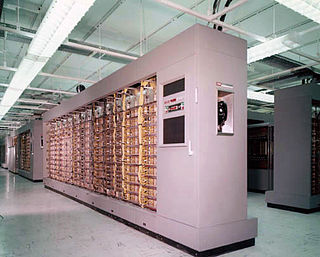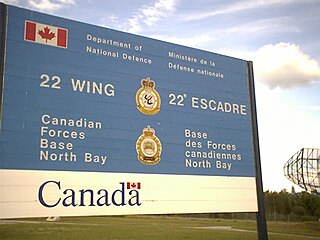
The Semi-Automatic Ground Environment (SAGE) was a system of large computers and associated networking equipment that coordinated data from many radar sites and processed it to produce a single unified image of the airspace over a wide area. SAGE directed and controlled the NORAD response to a possible Soviet air attack, operating in this role from the late 1950s into the 1980s. Its enormous computers and huge displays remain a part of cold war lore, and after decommissioning were common props in movies such as Dr. Strangelove and Colossus, and on science fiction TV series such as The Time Tunnel.

The AN/FSQ-7 Combat Direction Central, referred to as the Q7 for short, was a computerized air defence command and control system. It was used by the United States Air Force for ground-controlled interception as part of the Semi-Automatic Ground Environment network during the Cold War.
The IBM AN/FSQ-31 SAC Data Processing System was a USAF command, control, and coordination system for the Cold War Strategic Air Command (SAC). IBM's Federal Systems Division was the prime contractor for the AN/FSQ-31s, which were part of the TBD 465L SAC Automated Command and Control System (SACCS), a "Big L" system of systems (cf. 416L SAGE & 474L BMEWS( which had numerous sites throughout the Continental United States: "all SAC command posts and missile Launch Control Centers", a communication network, etc.; and the several FSQ-31 sites including:

The AN/FSQ-32 SAGE Solid State Computer was a planned military computer of the United States Air Force. It was central for deployment to Super Combat Centers in nuclear bunkers and to some above-ground military installations. In 1958, Air Defense Command planned to acquire 13 Q-32 centrals for several Air Divisions/Sectors.

The 26th Air Division is an inactive United States Air Force organization. Its last assignment was with Air Defense Tactical Air Command, assigned to First Air Force, being stationed at March Air Force Base, California. It was inactivated on 30 September 1990.

Topsham Air Force Station is a closed United States Air Force station. It is located 2.1 miles (3.4 km) north of Brunswick, Maine. It was closed in 1969.
Backup Interceptor Control was the Electronic Systems Division 416M System to backup the SAGE 416L System in the United States and Canada. BUIC deployed Cold War command, control, and coordination systems to SAGE radar stations to create dispersed NORAD Control Centers.
The Burroughs AN/GSA-51 Radar Course Directing Group was a United States Air Force air defense command, control, and coordination system, part of the Semi-Automatic Ground Environment system. It was intended to replace vacuum tube IBM AN/FSQ-7 Combat Direction Centrals. Developed under Electronic Systems Division's 416M Program, in 1962 Burroughs "won the contract to provide a military version of its D825" modular data processing system for the AN/GSA-51 to be used at "BUIC II radar sites" BUIC II was 1st used at North Truro Z-10 in 1966, and the Hamilton AFB BUIC II was installed in the former MCC building.
The Burroughs AN/FST-2 Coordinate Data Transmitting Set (CDTS) was a Cold War military computer system at SAGE radar stations for displaying aircraft tracks and converting them for digital transmission to IBM AN/FSQ-7 Combat Direction Centrals at air defense data centers. Developed by the Great Valley Research Laboratory of the Burroughs Corporation as part of the Electronic Systems Division's 416L network of computers, 134 CDTSs were deployed. Each was to "process the raw radar data, antenna position information, and IFF data, and send it over voice grade toll phone lines" at ~1200 baud with 1/4 mile precision. The transmissions were received as "Long Range Radar Input" at SAGE Direction Centers, which performed the aircraft control and warning operations and provided command information to Command Centers which forwarded data to the NORAD command center in Colorado. The AN/FST-2A included 2 vacuum tube computers and accepted 14 input signals.
A command, control, and coordination system (CCCS) was a Cold War computer system for United States command posts to use a single location to coordinate multiple units' ground-controlled interception and may refer to:
The GE AN/GPA-37 Course Directing Group was a USAF Cold War air defense command, control, and coordination system for weapons direction. During Air Defense Command's "Control Capability Improvement Program" to improve command guidance of manned aircraft, the AN/GPA-37 was "developed by the General Electric Heavy Military Electronic Equipment Department at Syracuse in conjunction with...Rome Air Development Center and the Electronics Research Laboratories of Columbia University." Used to process radar data, the system was to "track a potential enemy aircraft and direct intercepters [sic] into a position from which they can make their automatic firing runs", the system included the:
The GE AN/GPA-73 Radar Course Directing Group was an air defense command, control, and coordination system of the United States Air Force. It was developed for the Electronic Systems Division 412L Air Weapons Control System for weapons direction. The AN/GPA-73 was used to create a "Base Air Defense Ground Environment", for which Air Defense Command had recommended the system as "SAGE back-up control of BOMARC" in June 1958. When the GPA-73 was emplaced with the AN/FSA-21 Weapons Control Group computer for GCI, the system created a "miniature SAGE" military installation. The GPA-73 could also direct Project Nike surface-to-air missile fire from Nike Integrated Fire Control sites equipped with the "412 Target Designation System" in the Battery Control Van in a space allocated by February 1957 "behind the Acquition Operator [sic]". and the AN/GPA-73.

A Super Combat Center (SCC) was a planned Cold War command and control facility for ten NORAD regions/Air Divisions in Canada and the United States. For installation in nuclear bunkers, the command posts were to replace the last of the planned Air Defense Command Combat Centers to be built for vacuum tube AN/FSQ-8 Combat Control Centrals. The survivable SCCs were to use solid-state (transistorized) AN/FSQ-32 equipment which was to provide the Semi-Automatic Ground Environment for operators at 10 Air Divisions — 5 of the centers were to also serve as Air Defense Direction Centers ("SCC/DCs") for commanding ground-controlled interception in sectors of the 27th, 30th, 32nd, 33rd, and 35th Air Divisions. ADC's November 1958 plan to complete the hardened SCCs by April 1964 included fielding 3 additional AN/FSQ-32 systems above-ground for the Albuquerque, Miami, and Shreveport sectors.
An Air Defense Direction Center (ADDC) was a type of United States command post for assessing Cold War radar tracks, assigning height requests to available height-finder radars, and for "Weapons Direction": coordinating command guidance of aircraft from more than 1 site for ground-controlled interception. As with the World War II Aircraft Warning Service CONUS defense network, a "manual air defense system" was used through the 1950s Along with 182 radar stations at "the end of 1957, ADC operated … 17 control centers", and the Ground Observation Corps was TBD on TBD. With the formation of NORAD, several types of ADDCs were planned by Air Defense Command:

The Denver Air Defense Sector was a United States Air Force geographic area designated during the Cold War for both air defense and air traffic control, as well as the name of the planned military unit for conducting radar surveillance and fighter-interceptor operations in the sector area. The Denver ADS spanned the entire state of Colorado, nearly all of Utah, most of Wyoming and western Nebraska, and small parts of Kansas, Oklahoma, New Mexico, Arizona, and Nevada. Potential targets in the sector included the military/industrial facilities and urban civilian populations of the metropolitan areas at Salt Lake City, Cheyenne, Denver, and Colorado Springs..
NORAD Control Centers (NCCs) were Cold War "joint direction centers" for command, control, and coordination of ground-controlled interception by both USAF Air Defense Command (ADC) and Army Air Defense Command (ARADCOM). The Joint Manual Steering Group was "formed by the Army and Air Force in July 1957 to support…collocation" of USAF Air Defense Direction Centers and Army Air Defense Command Posts, which began after a January 28, 1958, ADC/ARADCOM meeting with NORAD to "collocate the Fairchild-Geiger facilities" Army contracts for 5 NCCs had been let by August 17, 1958, after 1956 DoD approval for collocation of interim "pre-SAGE semiautomatic intercept systems" and radar squadrons at 10 planned Army Missile Master AADCPs
Continental Air Defense Integration North (CADIN) was a Cold War program to develop military installations in Canada for the air defense of North America using the Semi Automatic Ground Environment already being deployed in the CONUS. CADIN was a revision of the 1955 Operation Pillow for a "Fourth Phase Radar Program" to "extend the combat zone northward" with additional radars in Canada After the 25 July 1958 NORAD plan included a single SAGE sector in Canada, Canada's Minister of National Defense proposed increased Canadian manning on the DEW Line, a right granted by the May 1955 US-Canada agreement. In December 1958 NORAD also approved 52 Canada radars with Frequency Diversity for FY61-63, and the initial 5 January 1959 CADIN cost sharing agreement was for 2 CIM-10 Bomarc squadrons, 7 heavy radars, 45 gap fillers, an Air Defense Direction Center, and SAGE upgrades for 25 existing radars. The USAF and RCAF approved on 13 July 1959 the construction of the Ottawa Super Combat Center to be "fully operational on 1 July 1963" to control BOMARC missile sites to be completed in 1962 at LaMacaza and North Bay. The cost sharing was for $305 million (USAF) and $135 million (RCAF) that included "tying into...32 ground-to-air radio sites."
The Experimental Semi-Automatic Ground Environment (SAGE) Sector was a prototype Cold War Air Defense Sector for developing the Semi Automatic Ground Environment. The Lincoln Laboratory control center in a new building was at Lexington, Massachusetts.

The ITT 465L Strategic Air Command Control System was a Cold War "Big L" network of computer and communication systems for command and control of Strategic Air Command "combat aircraft, refueling tankers, [and] ballistic missiles". International Telephone and Telegraph was the prime contractor for Project 465, and SACCS had "Cross Tell Links" between command posts at Offutt AFB, March AFB, & Barksdale AFB (SACCS also communicated with the Cheyenne Mountain Complex and Air Force command posts. The 465L System included IBM AN/FSQ-31 SAC Data Processing Systems, Remote and Simplex Remote Communication Systems, SAC Network Control Office, "4-wire, Schedule 4, Type 4B alternate voice-data operation", and one-way communication with "ICBM launch control centers" In addition to IBM for the "Super SAGE type computers", another of the 6 direct subcontractors was AT&T,
Marine Tactical Data System, commonly known as MTDS, was a mobile, ground based, aviation command and control system developed by the United States Marine Corps for the execution of anti-air warfare in support of the Fleet Marine Force (FMF). It was the Marine Corps' first semi-automated system capable of collecting, processing, computing and displaying aircraft surveillance data while also sharing that information with other participating units via tactical data link. The system was developed in the late 1950s/early 1960s when it was recognized that due to the speed, range and complexity of fighter aircraft operations effective air control and air defense demanded enhanced situational awareness.






